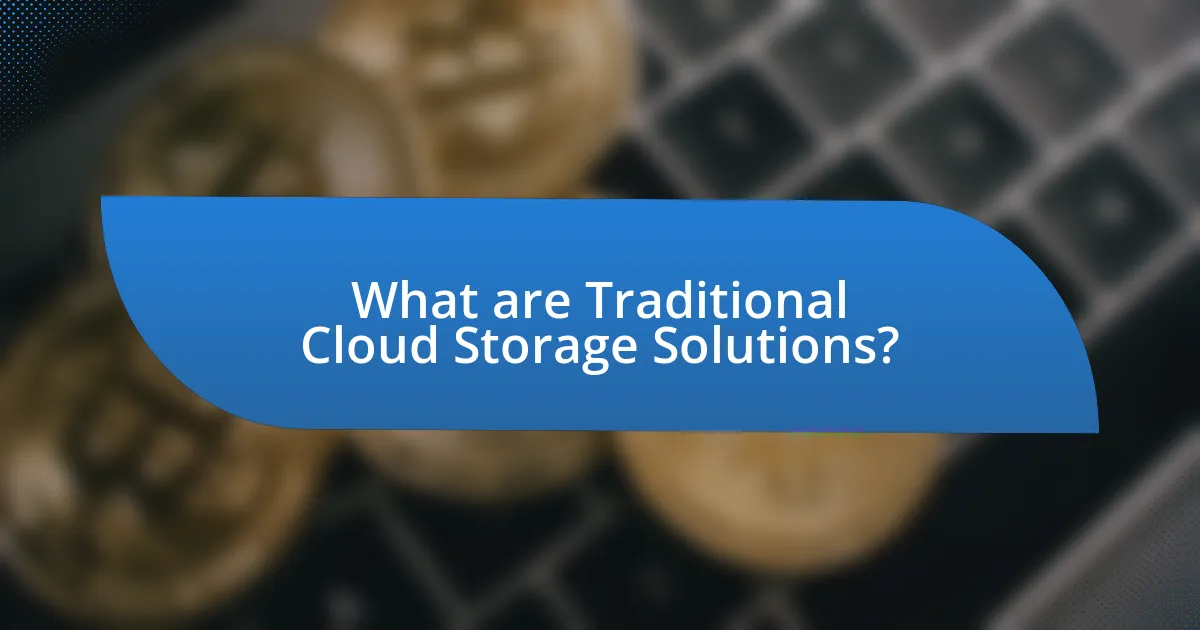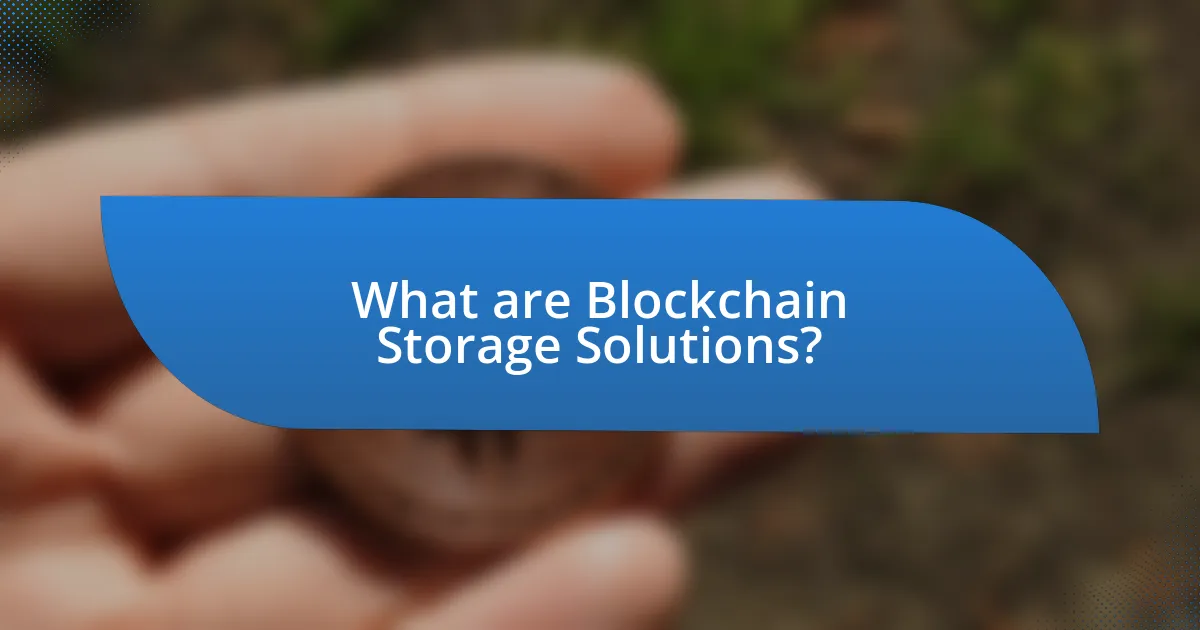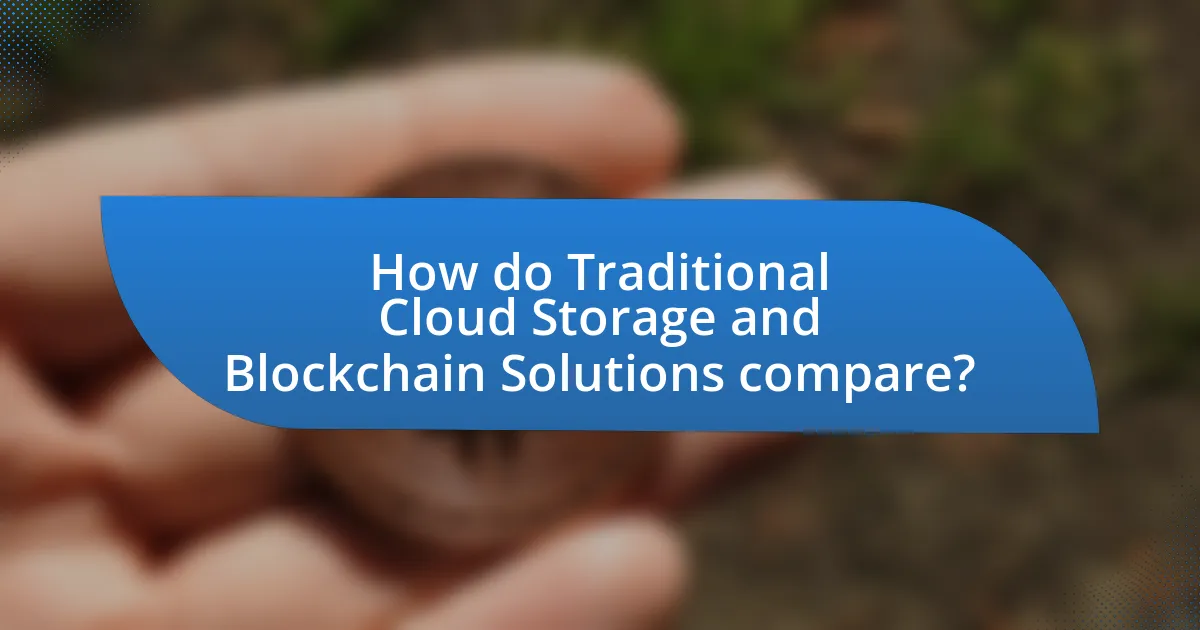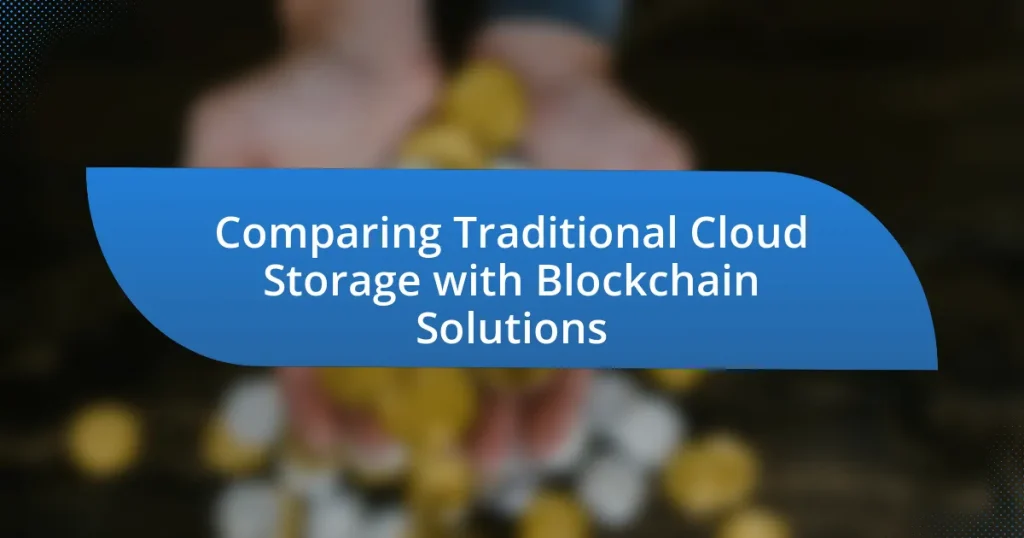The article focuses on comparing Traditional Cloud Storage Solutions with Blockchain Storage Solutions, highlighting their operational mechanisms, advantages, limitations, and security measures. Traditional cloud storage relies on centralized servers managed by third-party providers, offering scalability, cost-effectiveness, and ease of access, but also facing challenges such as data breaches and privacy concerns. In contrast, blockchain storage utilizes a decentralized network, enhancing data integrity and security through immutability and cryptographic techniques, while also presenting challenges related to scalability and regulatory compliance. The article further explores the specific use cases for each storage solution across various industries, guiding organizations in selecting the most suitable option based on their data management needs.

What are Traditional Cloud Storage Solutions?
Traditional cloud storage solutions are online services that allow users to store, manage, and access data over the internet using centralized servers. These solutions typically involve a subscription model where users pay for a certain amount of storage space provided by third-party companies, such as Amazon Web Services, Google Cloud, and Microsoft Azure. According to a report by Gartner, the global public cloud services market is projected to reach $623.3 billion by 2023, highlighting the widespread adoption and reliance on traditional cloud storage solutions for businesses and individuals alike.
How do Traditional Cloud Storage Solutions operate?
Traditional cloud storage solutions operate by allowing users to store data on remote servers managed by third-party service providers. These providers utilize a network of data centers to store, manage, and back up data, enabling users to access their files over the internet. For instance, companies like Amazon Web Services and Google Cloud Platform offer scalable storage options, where users can upload and retrieve data through web interfaces or APIs. This model relies on centralized control, meaning the service provider is responsible for data security, redundancy, and availability, which is supported by the fact that these providers often implement multiple layers of security and data replication across different geographic locations to ensure data integrity and accessibility.
What are the key components of Traditional Cloud Storage?
The key components of Traditional Cloud Storage include data storage, data management, data security, and network connectivity. Data storage refers to the physical servers and storage systems that hold user data, typically located in data centers. Data management encompasses the software and processes used to organize, retrieve, and maintain data efficiently. Data security involves measures such as encryption, access controls, and compliance protocols to protect data from unauthorized access and breaches. Network connectivity is essential for enabling users to access their data over the internet, relying on reliable bandwidth and infrastructure. These components work together to provide a cohesive cloud storage solution, ensuring data is accessible, secure, and manageable.
How do users access and manage data in Traditional Cloud Storage?
Users access and manage data in Traditional Cloud Storage primarily through web-based interfaces or dedicated applications. These platforms allow users to upload, download, and organize files, often utilizing drag-and-drop functionality for ease of use. Additionally, users can manage permissions and share files with others by generating links or inviting collaborators directly through the interface.
For instance, services like Google Drive and Dropbox provide user-friendly dashboards that facilitate file management, including features such as search functionality, folder organization, and version history. According to a report by Gartner, 94% of enterprises use cloud services for data storage, highlighting the widespread reliance on these platforms for data management.
What are the advantages of Traditional Cloud Storage?
Traditional cloud storage offers several advantages, including scalability, cost-effectiveness, and ease of access. Scalability allows businesses to adjust their storage needs based on demand, enabling them to pay only for the storage they use. Cost-effectiveness is evident as traditional cloud storage typically requires lower upfront investment compared to on-premises solutions, with many providers offering flexible pricing models. Additionally, ease of access ensures that users can retrieve and manage their data from anywhere with an internet connection, enhancing collaboration and productivity. These benefits make traditional cloud storage a practical choice for many organizations.
How does Traditional Cloud Storage ensure data availability?
Traditional cloud storage ensures data availability through redundancy, data replication, and robust infrastructure. Redundancy involves storing multiple copies of data across different servers and locations, which protects against data loss due to hardware failures. Data replication further enhances availability by synchronizing data across various data centers, ensuring that if one center goes down, others can provide access to the data. Additionally, traditional cloud providers utilize high-availability architectures, including load balancing and failover mechanisms, to maintain continuous access to data. These strategies collectively contribute to a reliable system that can deliver data consistently, even in the event of disruptions.
What cost benefits does Traditional Cloud Storage provide?
Traditional cloud storage provides cost benefits primarily through reduced infrastructure expenses and scalable pricing models. Organizations can avoid the high upfront costs associated with purchasing and maintaining physical servers by utilizing cloud services, which typically operate on a pay-as-you-go basis. This model allows businesses to only pay for the storage they use, leading to significant savings, especially for small to medium-sized enterprises. According to a report by Gartner, companies can save up to 30% on IT costs by migrating to cloud storage solutions compared to traditional on-premises systems. Additionally, traditional cloud storage often includes built-in redundancy and backup solutions, further minimizing the costs associated with data loss and recovery.
What are the limitations of Traditional Cloud Storage?
Traditional cloud storage has several limitations, including dependency on a centralized server, which creates a single point of failure. This centralization can lead to data breaches, as evidenced by incidents like the 2019 Capital One breach, where over 100 million accounts were compromised due to a vulnerability in the cloud infrastructure. Additionally, traditional cloud storage often incurs ongoing costs for data retrieval and storage, which can accumulate significantly over time. Furthermore, data access can be hindered by internet connectivity issues, impacting the availability of critical information. Lastly, traditional cloud storage may not provide adequate data integrity and immutability, making it susceptible to unauthorized alterations or deletions.
How does data security compare in Traditional Cloud Storage?
Data security in Traditional Cloud Storage is generally centralized, relying on the service provider to implement security measures. This centralization can lead to vulnerabilities, as a single breach can compromise all stored data. For instance, a 2020 report by the Identity Theft Resource Center indicated that cloud service providers experienced a significant number of data breaches, affecting millions of users. In contrast, decentralized solutions like blockchain distribute data across multiple nodes, enhancing security by reducing the risk of a single point of failure. Thus, while Traditional Cloud Storage offers convenience, its centralized nature poses greater risks to data security compared to decentralized alternatives.
What challenges do users face with data privacy in Traditional Cloud Storage?
Users face significant challenges with data privacy in Traditional Cloud Storage, primarily due to centralized control and potential data breaches. Centralized cloud providers manage user data, which increases the risk of unauthorized access and data leaks, as evidenced by incidents like the 2019 Capital One breach that exposed over 100 million customer records. Additionally, users often lack transparency regarding how their data is stored, processed, and shared, leading to concerns about compliance with regulations such as GDPR. These factors contribute to a heightened vulnerability of sensitive information in traditional cloud environments.

What are Blockchain Storage Solutions?
Blockchain storage solutions are decentralized systems that utilize blockchain technology to store and manage data securely. These solutions leverage the inherent characteristics of blockchain, such as immutability, transparency, and distributed consensus, to provide a more secure alternative to traditional cloud storage. For instance, data stored on a blockchain is encrypted and distributed across multiple nodes, reducing the risk of data breaches and ensuring that no single entity has control over the entire dataset. This decentralized approach enhances data integrity and availability, as evidenced by projects like Filecoin and Storj, which demonstrate the practical application of blockchain for data storage.
How do Blockchain Storage Solutions function?
Blockchain storage solutions function by distributing data across a decentralized network of nodes, ensuring that each piece of information is stored in a secure and tamper-proof manner. In this system, data is divided into blocks, which are linked together in a chronological chain, and each block contains a cryptographic hash of the previous block, a timestamp, and transaction data. This structure not only enhances security through redundancy but also allows for transparency, as all participants in the network can access the same data without the need for a central authority. The decentralized nature of blockchain storage eliminates single points of failure, making it more resilient compared to traditional cloud storage systems, which rely on centralized servers.
What are the fundamental elements of Blockchain Storage?
The fundamental elements of Blockchain Storage include decentralization, immutability, transparency, and security. Decentralization ensures that data is distributed across a network of nodes, eliminating a single point of failure and enhancing resilience. Immutability guarantees that once data is recorded on the blockchain, it cannot be altered or deleted, providing a permanent and verifiable record. Transparency allows all participants in the network to access and verify the data, fostering trust among users. Security is achieved through cryptographic techniques that protect data from unauthorized access and tampering. These elements collectively differentiate blockchain storage from traditional cloud storage systems, which typically rely on centralized servers and may lack the same level of data integrity and security.
How is data stored and retrieved in Blockchain Storage?
Data in Blockchain Storage is stored in a decentralized manner across a network of nodes, where each block contains a list of transactions and a cryptographic hash of the previous block, forming a secure chain. This structure ensures that once data is recorded, it cannot be altered without consensus from the network, providing immutability and transparency. Retrieval of data occurs through querying the blockchain, where nodes validate and provide access to the stored information based on the consensus mechanism, such as Proof of Work or Proof of Stake. This method contrasts with traditional cloud storage, where data is typically stored in centralized servers, making it more vulnerable to breaches and data loss.
What benefits do Blockchain Storage Solutions offer?
Blockchain storage solutions offer enhanced security, decentralization, and data integrity compared to traditional cloud storage. The decentralized nature of blockchain means that data is distributed across multiple nodes, reducing the risk of data breaches and single points of failure. Additionally, blockchain employs cryptographic techniques that ensure data is tamper-proof, providing a higher level of trust and transparency. According to a report by Deloitte, blockchain technology can reduce data management costs by up to 30% due to its efficiency and reduced need for intermediaries. Furthermore, the immutability of blockchain records ensures that once data is entered, it cannot be altered, which is crucial for industries requiring strict compliance and audit trails.
How does Blockchain enhance data security?
Blockchain enhances data security by utilizing a decentralized and immutable ledger system. This technology ensures that once data is recorded, it cannot be altered or deleted without consensus from the network, significantly reducing the risk of unauthorized access and data tampering. Each transaction is encrypted and linked to the previous one, creating a chain of blocks that is transparent and verifiable. According to a study by the World Economic Forum, blockchain can reduce data breaches by up to 80% due to its inherent security features, making it a more secure alternative to traditional cloud storage systems.
What advantages does Blockchain provide in terms of data integrity?
Blockchain provides enhanced data integrity through its decentralized and immutable nature. Each transaction or data entry is recorded in a block and linked to the previous block, creating a secure chain that is resistant to tampering. This structure ensures that once data is added, it cannot be altered without consensus from the network, making unauthorized changes nearly impossible. Additionally, the use of cryptographic hashing further secures the data, as any modification would change the hash and signal an inconsistency. According to a study by the Massachusetts Institute of Technology, blockchain technology can reduce data manipulation risks significantly, demonstrating its effectiveness in maintaining data integrity compared to traditional cloud storage systems.
What are the challenges associated with Blockchain Storage Solutions?
Blockchain storage solutions face several challenges, including scalability, data retrieval speed, and regulatory compliance. Scalability issues arise because as the number of transactions increases, the blockchain can become congested, leading to slower processing times. Data retrieval speed is often hindered by the decentralized nature of blockchain, which can complicate quick access to stored information. Additionally, regulatory compliance poses a challenge, as varying laws across jurisdictions can complicate the implementation of blockchain solutions, particularly concerning data privacy and security. These challenges highlight the complexities involved in adopting blockchain technology for storage compared to traditional cloud solutions.
How does scalability impact Blockchain Storage?
Scalability significantly impacts blockchain storage by determining the system’s ability to handle increased data volume and transaction throughput. As blockchain networks grow, the storage requirements for maintaining a complete and accurate ledger also increase, which can lead to challenges such as slower transaction speeds and higher costs for data storage. For instance, Bitcoin’s blockchain has grown to over 400 GB, necessitating efficient storage solutions to accommodate its expanding size while ensuring accessibility and performance. Additionally, scalability solutions like sharding and layer-2 protocols aim to enhance transaction processing without compromising the integrity of the blockchain, thereby addressing the storage challenges associated with increased scalability demands.
What are the potential costs involved in implementing Blockchain Storage?
The potential costs involved in implementing Blockchain Storage include infrastructure expenses, transaction fees, and ongoing maintenance costs. Infrastructure expenses arise from the need for specialized hardware and software to support blockchain technology, which can be significantly higher than traditional cloud storage setups. Transaction fees are incurred each time data is added or modified on the blockchain, and these fees can vary based on network congestion and the specific blockchain used. Ongoing maintenance costs involve the need for skilled personnel to manage and secure the blockchain environment, which can lead to higher operational costs compared to conventional storage solutions. According to a report by Deloitte, organizations can expect to spend between 10% to 30% more on blockchain infrastructure compared to traditional systems, highlighting the financial implications of adopting this technology.

How do Traditional Cloud Storage and Blockchain Solutions compare?
Traditional cloud storage and blockchain solutions differ primarily in their data management and security approaches. Traditional cloud storage relies on centralized servers managed by service providers, which can lead to vulnerabilities such as data breaches and single points of failure. In contrast, blockchain solutions utilize a decentralized network of nodes to store data, enhancing security through cryptographic techniques and immutability, making unauthorized alterations nearly impossible.
For instance, a study by Gartner indicates that by 2025, 80% of enterprises will migrate to cloud services, highlighting the widespread adoption of traditional cloud storage. However, blockchain’s unique attributes, such as transparency and traceability, are increasingly appealing for applications requiring high security, like financial transactions and supply chain management. This comparison underscores the strengths and weaknesses inherent in each approach, with traditional cloud storage offering convenience and scalability, while blockchain provides enhanced security and trust.
What are the key differences between Traditional Cloud Storage and Blockchain Solutions?
Traditional cloud storage relies on centralized servers managed by service providers, while blockchain solutions utilize a decentralized network of nodes to store data. In traditional cloud storage, data is controlled by a single entity, which can lead to vulnerabilities such as data breaches and service outages. Conversely, blockchain’s decentralized nature enhances security and transparency, as data is distributed across multiple nodes, making it more resistant to tampering and unauthorized access. Additionally, traditional cloud storage typically involves subscription fees for storage space, whereas blockchain solutions often use cryptocurrency for transactions, which can introduce different economic models. These differences highlight the contrasting approaches to data management and security in each system.
How do security measures differ between the two storage methods?
Security measures differ significantly between traditional cloud storage and blockchain solutions. Traditional cloud storage relies on centralized servers, which makes it vulnerable to data breaches and unauthorized access, as evidenced by numerous high-profile hacks affecting major providers. In contrast, blockchain solutions utilize decentralized networks, where data is encrypted and distributed across multiple nodes, enhancing security through redundancy and making it nearly impossible for a single point of failure to compromise the entire system. This decentralized approach is supported by cryptographic techniques that ensure data integrity and authenticity, as seen in the use of hash functions and consensus algorithms.
What are the implications of data ownership in each solution?
Data ownership in traditional cloud storage implies that service providers retain control over user data, which can lead to privacy concerns and potential data breaches. In contrast, blockchain solutions grant users full ownership and control over their data, enhancing security and transparency. For instance, in traditional cloud storage, companies like Amazon Web Services or Google Cloud can access and manage user data, which raises risks of unauthorized access or data loss. Conversely, blockchain technology utilizes decentralized networks where data is encrypted and distributed, ensuring that only the data owner can access or modify it. This fundamental difference in data ownership impacts user trust, regulatory compliance, and the overall security landscape of data management solutions.
What are the use cases for each storage solution?
Traditional cloud storage is primarily used for data backup, file sharing, and collaboration, making it suitable for businesses and individuals needing easy access to files from multiple devices. For example, services like Google Drive and Dropbox allow users to store documents, photos, and videos, facilitating real-time collaboration among teams.
In contrast, blockchain storage solutions are utilized for secure data integrity, decentralized applications, and immutable record-keeping, which is essential for industries like finance, healthcare, and supply chain management. For instance, platforms like Filecoin and Storj leverage blockchain technology to ensure data is stored securely and transparently, preventing unauthorized access and ensuring data provenance.
Which industries benefit more from Traditional Cloud Storage?
The industries that benefit more from Traditional Cloud Storage include healthcare, finance, and retail. Healthcare organizations utilize cloud storage for secure patient data management and compliance with regulations like HIPAA, which mandates data protection. Financial institutions leverage cloud storage for transaction data and customer information, ensuring quick access and disaster recovery capabilities. Retail businesses benefit from cloud storage by managing inventory data and customer analytics, enabling efficient operations and personalized marketing strategies. These industries rely on the scalability, cost-effectiveness, and accessibility of traditional cloud storage solutions to enhance their operational efficiency and data management practices.
What sectors are adopting Blockchain Storage Solutions?
Various sectors are adopting Blockchain Storage Solutions, including finance, healthcare, supply chain management, and government. The finance sector utilizes blockchain for secure transactions and fraud prevention, while healthcare employs it for secure patient data management and interoperability. Supply chain management benefits from enhanced transparency and traceability of goods, and government agencies leverage blockchain for secure record-keeping and identity verification. These sectors are increasingly recognizing the advantages of blockchain technology in improving data security, integrity, and operational efficiency.
How can organizations choose between Traditional Cloud Storage and Blockchain Solutions?
Organizations can choose between Traditional Cloud Storage and Blockchain Solutions by evaluating their specific needs for data security, transparency, and scalability. Traditional Cloud Storage offers centralized control and ease of access, making it suitable for businesses that prioritize convenience and cost-effectiveness. In contrast, Blockchain Solutions provide decentralized data integrity and enhanced security through cryptographic methods, which is ideal for organizations requiring high levels of trust and auditability in transactions. For instance, a study by Gartner indicates that 70% of organizations are adopting cloud services for their flexibility, while a report from Deloitte highlights that 40% of enterprises are exploring blockchain for its potential to reduce fraud and increase transparency. Thus, the choice hinges on whether the organization values centralized efficiency or decentralized security and trust.
What factors should be considered when selecting a storage solution?
When selecting a storage solution, key factors include data security, scalability, cost, accessibility, and compliance with regulations. Data security is crucial as it protects sensitive information from breaches; for instance, blockchain solutions offer enhanced security through decentralization and encryption. Scalability ensures that the storage solution can grow with the organization’s needs, which is vital for businesses experiencing rapid growth. Cost considerations involve both initial investment and ongoing operational expenses, where traditional cloud storage may have lower upfront costs but can accumulate higher long-term fees. Accessibility refers to how easily users can retrieve and manage their data, with cloud solutions typically providing more user-friendly interfaces. Lastly, compliance with regulations, such as GDPR or HIPAA, is essential to avoid legal issues, and different storage solutions may offer varying levels of compliance support.
How can organizations assess their specific storage needs?
Organizations can assess their specific storage needs by conducting a thorough analysis of their data requirements, including volume, type, and access frequency. This involves evaluating current data storage usage, forecasting future growth, and identifying compliance and security requirements. For instance, a study by Gartner indicates that organizations should consider a 30% increase in data storage needs annually due to digital transformation initiatives. By utilizing tools such as data inventory assessments and storage utilization metrics, organizations can make informed decisions about the appropriate storage solutions, whether traditional cloud storage or blockchain-based systems, to meet their evolving needs effectively.
What best practices should organizations follow when implementing storage solutions?
Organizations should follow several best practices when implementing storage solutions, including assessing their specific storage needs, ensuring data security, and planning for scalability. A thorough assessment helps identify the types of data to be stored and the required access speeds, which informs the choice between traditional cloud storage and blockchain solutions. Data security is critical; organizations should implement encryption and access controls to protect sensitive information, as breaches can lead to significant financial and reputational damage. Additionally, planning for scalability ensures that the storage solution can grow with the organization, accommodating increasing data volumes without performance degradation. According to a report by Gartner, organizations that prioritize these best practices can reduce storage costs by up to 30% while improving data management efficiency.


